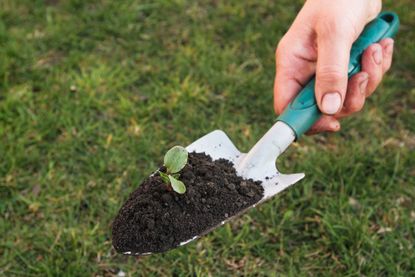Garden Trowel Information: What Is A Trowel Used For In Gardening


If someone were to ask me what gardening tools I could not live without, my answer would be a trowel, gloves, and pruners. While I do have one pair of heavy-duty, expensive pruners that I've had for a few years, at the beginning of each landscape season I buy several inexpensive pruners because I know I have a habit of misplacing them. It's shameful, really, how many pairs of gloves and pruners I have gone through over the years. My garden trowel is a very different story, though. I have had the same favorite garden trowel for about ten years now. It is one of my most prized possessions. So, what is a trowel and why is it an essential tool for every gardener to own? Continue reading for garden trowel information.
Using Gardening Trowels
In masonry, a trowel is a flat tool that is used to apply and spread mortar or plaster. This type of trowel is different than a garden trowel, however. A garden trowel is a small, handheld shovel or spade. Garden trowels usually have wooden, plastic, or rubber-coated metal handles. The actual shovel part of a garden trowel can be made of various types of metal or even plastic, sometimes the metal blades are coated or painted. These handheld shovels are available in different widths, generally 1 to 5 inches (2.5-13 cm.) across. Which width you choose is a matter of personal preference, though certain widths are better for specific jobs. Garden trowels can also have flat, curved, or even scoop-shaped blades. My beloved garden trowel is a pretty basic one with a stainless-steel blade and wooden handle. If memory serves me right, I paid $6.99 (USD) for it about ten years ago. Through the years, I have purchased other garden trowels, usually because they look neat. All these other trowels have ended up broken and in the trash. Garden trowels that are not made of stainless steel have a nasty habit of bending, breaking, or rusting. Over time, painted or coated blades chip and begin to rust. I've also had many problems with the rubber on the handles of trowels ripping off or disintegrating. I will admit, however, that even wooden garden trowel handles can crack or swell if exposed to the elements for too long. Proper cleaning and storage of any garden trowel will increase its life. Trowel blades should be cleaned, sanitized, and wiped dry after each use. Like pruners, infected garden trowels can spread diseases from plant to plant. Garden trowels should never be left outdoors at any time of the year, and they should be stored in a garage or shed through winter. The best way to store garden trowels, when not in use, is by hanging them up. Most garden trowels have a hole at the end of the handle for hanging.
When and How to Use a Trowel in the Garden
When to use a gardening trowel depends on the job at hand. Garden trowels are used for digging small holes, such for planting bulbs, annuals, or perennials. It would take a lot of time and effort to dig a hole for a tree or shrub with a garden trowel. Garden trowels are also used to dig up weeds. In small, tight areas, a narrow-width blade will work better to dig out weeds or to install small plants or bulbs. Flat trowel blades work better on weeds with long taproots. Wider trowel blades and scoop-shaped blades work best for digging up small plants, digging holes for perennials, or scooping up soil when potting plants.
Gardening tips, videos, info and more delivered right to your inbox!
Sign up for the Gardening Know How newsletter today and receive a free download of our most popular eBook "How to Grow Delicious Tomatoes."